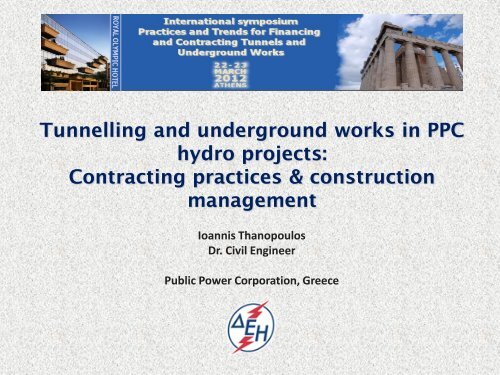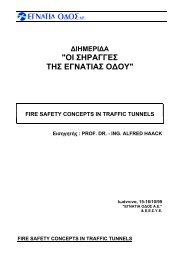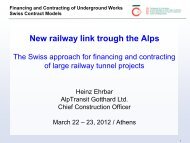Tunnelling and underground works in PPC hydro projects ...
Tunnelling and underground works in PPC hydro projects ...
Tunnelling and underground works in PPC hydro projects ...
You also want an ePaper? Increase the reach of your titles
YUMPU automatically turns print PDFs into web optimized ePapers that Google loves.
<strong>Tunnell<strong>in</strong>g</strong> <strong>and</strong> <strong>underground</strong> <strong>works</strong> <strong>in</strong> <strong>PPC</strong><br />
<strong>hydro</strong> <strong>projects</strong>:<br />
Contract<strong>in</strong>g practices & construction<br />
management<br />
Ioannis Thanopoulos<br />
Dr. Civil Eng<strong>in</strong>eer<br />
Public Power Corporation, Greece
Public Power Corporation S. A.<br />
a 49% privatized company with extensive experience on<br />
<strong>hydro</strong>electric <strong>projects</strong> realization<br />
Topic presented:<br />
The practice used <strong>in</strong> <strong>PPC</strong> for contract<strong>in</strong>g <strong>and</strong> execut<strong>in</strong>g<br />
<strong>underground</strong> <strong>works</strong>
Underground structures <strong>in</strong> a <strong>hydro</strong> project:<br />
• diversion <strong>and</strong> power tunnels,<br />
• tailrace <strong>and</strong> bottom outlet tunnels<br />
• adits for grout<strong>in</strong>g <strong>and</strong> dra<strong>in</strong>age.<br />
• power station caverns,
Hydro-Electric Projects completed <strong>in</strong> the<br />
last decades <strong>in</strong>clude:<br />
• Pigai Aoos with tunnels <strong>and</strong> an <strong>underground</strong> power house<br />
complex <strong>in</strong> a depth of 400m,<br />
• Thissavros HEP featur<strong>in</strong>g an <strong>underground</strong> power plant,<br />
largest <strong>in</strong> Greece<br />
• Ilarion HEP with spillway tunnels up to 12m diameter<br />
• Messochora HEP with a 7, 5 km long power tunnel.<br />
Thissavros HEP
<strong>PPC</strong> S.A.-Generation/Hydroelectric Generation<br />
Department organisation:<br />
• 70s: foundation of the “Bureau” of Hydro <strong>projects</strong> design<br />
• Upgraded <strong>in</strong> a branch of the company, the Hydroelectric Projects<br />
Development Department<br />
• Nowadays, the activity is embedded <strong>in</strong> the Hydroelectric Generation<br />
Department<br />
Design <strong>and</strong> construction branches <strong>in</strong>cluded<br />
Hydro scheme design <strong>and</strong> execution stages<br />
Owner controlled procedure adopted for design, bidd<strong>in</strong>g,<br />
contract assignment, <strong>and</strong> supervision of <strong>works</strong>
Design branch tasks:<br />
• Hydrology assessment,<br />
• Hydro potential evaluation, feasibility studies, environmental<br />
assessment <strong>and</strong> permits issu<strong>in</strong>g<br />
• Survey<strong>in</strong>g <strong>and</strong> expropriation.<br />
• Geotechnical <strong>and</strong> geological studies for the dams <strong>and</strong> relative<br />
structures<br />
• Civil <strong>works</strong> design<br />
• Electromechanical design
Construction branch tasks:<br />
• Prepar<strong>in</strong>g bidd<strong>in</strong>g documents<br />
• Contract assignment<br />
• Deal<strong>in</strong>g with the questions-claims aris<strong>in</strong>g <strong>in</strong> the construction<br />
phase.<br />
• Manag<strong>in</strong>g site offices
Site supervision units tasks:<br />
• Manag<strong>in</strong>g the various contracts.<br />
• Supervis<strong>in</strong>g timely <strong>and</strong> accord<strong>in</strong>g to the specifications<br />
execution of <strong>works</strong><br />
• Decid<strong>in</strong>g <strong>in</strong> a first stage on any question concern<strong>in</strong>g<br />
contractual issues<br />
The site office is very well organised with discipl<strong>in</strong>es <strong>in</strong>clud<strong>in</strong>g<br />
eng<strong>in</strong>eers, geologists, technicians, foremen, adm<strong>in</strong>istration support etc
Project stages<br />
• Feasibility Study: evaluation of the site’s potential +<br />
overall technical estimation of the conditions<br />
• Prelim<strong>in</strong>ary Design phase: ma<strong>in</strong> questions are<br />
assessed <strong>and</strong> project’s ma<strong>in</strong> data def<strong>in</strong>ed.<br />
-<strong>hydro</strong>logy analysis<br />
-geotechnical <strong>in</strong>vestigation program<br />
Especially for <strong>underground</strong> <strong>works</strong>, extensive<br />
<strong>in</strong>vestigation is implemented with drill<strong>in</strong>g <strong>and</strong> test<strong>in</strong>g of<br />
cores.<br />
Rock mass classification is done <strong>and</strong> support measures<br />
assessment accord<strong>in</strong>g to the NATM pr<strong>in</strong>ciples.
Project stages (cont.)<br />
• Design phase: analysis of surface <strong>and</strong> <strong>underground</strong><br />
structures, detailed draw<strong>in</strong>gs preparation, measurement of<br />
quantities <strong>and</strong> preparation of bidd<strong>in</strong>g documents.<br />
• Bidd<strong>in</strong>g procedure for a project: this may <strong>in</strong>clude multiple<br />
contracts for civil <strong>and</strong> electromechanical <strong>works</strong>, depend<strong>in</strong>g on<br />
the tim<strong>in</strong>g for implementation <strong>and</strong> the specialization of the<br />
contractor.<br />
• Construction phase <strong>in</strong> which the contracts are activated <strong>in</strong><br />
stages, start<strong>in</strong>g from the diversion tunnel <strong>works</strong> <strong>and</strong><br />
progress<strong>in</strong>g with dam <strong>and</strong> appurtenant structures<br />
construction, the implementation of the power tunnel <strong>and</strong><br />
power house contracts. Supervision of <strong>works</strong> accord<strong>in</strong>g to the<br />
specifications <strong>and</strong> coord<strong>in</strong>ation of the contractors is the task<br />
of the site office
Underground excavations:<br />
Complex <strong>works</strong> with uncerta<strong>in</strong>ties aris<strong>in</strong>g from the difficulty of<br />
assess<strong>in</strong>g precisely the actual ground conditions
Key contractual conditions <strong>in</strong> <strong>underground</strong><br />
<strong>works</strong>:<br />
The contractor<br />
• Is fully aware of the results of the geotechnical <strong>in</strong>vestigations<br />
executed <strong>in</strong> the design.<br />
• Is responsible for assum<strong>in</strong>g rock mass properties <strong>and</strong><br />
behavior <strong>and</strong> for choos<strong>in</strong>g excavation means <strong>and</strong> effective<br />
support<br />
In reality,<br />
• Management of the <strong>underground</strong> <strong>works</strong> <strong>in</strong> <strong>PPC</strong> contracts<br />
endorses a comprehensive level of flexibility, while the day by<br />
day collaboration between both parts at site guarantees the<br />
smooth h<strong>and</strong>l<strong>in</strong>g out of the job. So, a fair risk shar<strong>in</strong>g<br />
between the owner <strong>and</strong> the contractor is practically achieved.
Key contractual conditions <strong>in</strong> <strong>underground</strong><br />
<strong>works</strong> (cont.)<br />
Detailed unit prices are provided for all tunnel<strong>in</strong>g<br />
items expected to be needed<br />
flexibility <strong>in</strong> adapt<strong>in</strong>g the job to the real conditions<br />
• Payment is made for actual tunnel<strong>in</strong>g work
Key contractual conditions <strong>in</strong> <strong>underground</strong><br />
<strong>works</strong> (cont.)<br />
• rock classification <strong>and</strong> appropriate support type are decided<br />
at the tunnel face, with mutual agreement between owner’s<br />
<strong>and</strong> contractor’s eng<strong>in</strong>eers <strong>and</strong> geologists<br />
• The decision is based on well def<strong>in</strong>ed criteria that, <strong>in</strong> the<br />
latest contracts are based on rock type description, strength<br />
<strong>and</strong> fractur<strong>in</strong>g evaluation, rock mass GSI rat<strong>in</strong>g results of <strong>in</strong>situ<br />
<strong>in</strong>spections, <strong>hydro</strong> geological rout<strong>in</strong>e documentation, <strong>and</strong><br />
geotechnical measurements.<br />
• Day by day evaluation <strong>and</strong> <strong>in</strong>terpretation of such <strong>in</strong>formation<br />
helped <strong>in</strong> runn<strong>in</strong>g the contracts without problems <strong>in</strong> most of<br />
the cases.
Key contractual conditions <strong>in</strong> <strong>underground</strong><br />
<strong>works</strong>(cont.)<br />
Alteration <strong>in</strong> ground conditions outside contract limits:<br />
• Is practically tackled with extra support measures applied<br />
by the contractor <strong>and</strong>/or changes <strong>in</strong> the methodology.<br />
This may be done without the immediate approval from the<br />
supervision or the designer<br />
• the advice of an outside tunnel<strong>in</strong>g expert is usually followed.
Contractual conditions <strong>in</strong> <strong>underground</strong><br />
<strong>works</strong> (cont.)<br />
In the case of no agreement, a procedure for deal<strong>in</strong>g with<br />
claims is prescribed <strong>in</strong> the contract, that <strong>in</strong>cludes:<br />
• Exam<strong>in</strong>ation of the case from the site office upon submittal<br />
from the contractor of all the related documents with<strong>in</strong> a<br />
period of 30 days<br />
• If no agreement is achieved, the claim is transferred to the<br />
manag<strong>in</strong>g unit of <strong>PPC</strong>/HGD<br />
• In the case of f<strong>in</strong>al non agreement, a procedure of “amicable<br />
settlement” can be triggered before the case arrives to court.<br />
The exam<strong>in</strong>ation of the claim by an <strong>in</strong>dependent committee<br />
can be done <strong>and</strong> this gives the possibility to settle the matter<br />
<strong>in</strong> most cases.
Focus on specific <strong>projects</strong><br />
Pigai Aoos<br />
• The project comprises a Ma<strong>in</strong> earthfill dam 80m high <strong>and</strong> 6<br />
saddle dams, a 144,5x10 6 m 3 net storage reservoir, situated on<br />
a high elevation plateau, between el. 1300 <strong>and</strong> 1400m a.s.l.<br />
• outflow from the power house ends down to the Metsovitiko river<br />
at el. 650m a.s.l.
Pigai Aoos<br />
<strong>underground</strong> structures:<br />
• diversion tunnel 0,65km long,<br />
• headrace system (tunnel <strong>and</strong> penstock) 3,5km long,<br />
• vertical shaft 440m high,<br />
• <strong>underground</strong> 210 MW power house <strong>and</strong><br />
• tailrace tunnel 2,8km long.<br />
3 ma<strong>in</strong> tunnell<strong>in</strong>g contracts were implemented<br />
NATM pr<strong>in</strong>ciples were not directly endorsed at that time <strong>in</strong> the technical<br />
specifications. <strong>and</strong> rock classes were not def<strong>in</strong>ed, work was practically done by<br />
estimat<strong>in</strong>g rock quality at the tunnel face by supervision geologists <strong>and</strong> the<br />
eng<strong>in</strong>eer <strong>in</strong> collaboration with the contractor <strong>and</strong> adjust<strong>in</strong>g the support<br />
measures accord<strong>in</strong>gly.
Pigai Aoos<br />
Contract PAH-1<br />
• Excavation of the 1,6km long<br />
access to the powerhouse<br />
tunnel <strong>and</strong> the 2,7km tailrace<br />
tunnel.<br />
• Contractor: Norwegian firm<br />
SELMER-FURUHOLMEN<br />
• Contractual cost 1,7x10 6 euro<br />
(equivalent price 1981)
Pigai Aoos<br />
Contract PAH-1<br />
• Difficulties encountered ma<strong>in</strong>ly concerned poor geological<br />
conditions of the tailrace drive that was ma<strong>in</strong>ly mechanically<br />
bored, with a roadheader mach<strong>in</strong>e, through flysh formations,<br />
mostly folded, <strong>and</strong> fractured claystone.<br />
Large deformations were<br />
locally observed <strong>and</strong> a<br />
wide range of support<br />
measures, <strong>in</strong>clud<strong>in</strong>g steel<br />
sets <strong>in</strong> the 20% of the<br />
total length of the tunnel,<br />
had to be applied.
Pigai Aoos<br />
Contract PAH-1<br />
• Outside <strong>in</strong>ternational arbitrage has been implemented, as it<br />
was foreseen <strong>in</strong> the contractual documents, <strong>in</strong> resolv<strong>in</strong>g ma<strong>in</strong><br />
questions <strong>and</strong> claims focused on geological conditions of the<br />
tailrace tunnel.<br />
• A 2,5 years period was necessary to complete the excavation<br />
<strong>and</strong> l<strong>in</strong><strong>in</strong>g with cost overrun for the contract approximately at<br />
26% , which was fully justified tak<strong>in</strong>g <strong>in</strong>to account the<br />
conditions
Pigai Aoos<br />
Contract PAH-2SA<br />
• Excavation & concret<strong>in</strong>g of the 3,2 km long power tunnel,<br />
end<strong>in</strong>g at the surge shaft, <strong>and</strong> the upper valve chamber.<br />
Contractor “ODON & ODOSTROMATON”<br />
• In good rock conditions, ma<strong>in</strong>ly <strong>in</strong> s<strong>and</strong>stone formations<br />
requir<strong>in</strong>g bolt<strong>in</strong>g <strong>and</strong> shotcrete support.<br />
• duration of the contract:<br />
3 years<br />
• 21% cost overrun on the<br />
4,2 equivalent million<br />
euro contract (prices<br />
1981)<br />
• Very small amount of<br />
cost <strong>in</strong>crease <strong>in</strong> the<br />
tunnel.<br />
• No major claims were<br />
made by the contractor.
Pigai Aoos<br />
Contract PAH-2SB<br />
excavation of the<br />
• powerhouse cavern (66x18x29m)<br />
• valve chamber (39x7x11), the<br />
• transformers chamber (31x14x12,5m)<br />
• vertical penstock shaft, 440m high, down to the power house.<br />
• A number of access galleries were <strong>in</strong>cluded <strong>in</strong> the contractor’s<br />
methodology (Norwegian firm NOCON).<br />
Contractual cost: 2,25 million euro (equivalent price, 1981)
Pigai Aoos<br />
powerhouse cavern (66x18x29m)<br />
vertical penstock shaft, 440m high<br />
transformers chamber<br />
(31x14x12,5m)<br />
valve chamber (39x7x11
Pigai Aoos<br />
Contract PAH-2SB<br />
• Good rock conditions were encountered, ma<strong>in</strong>ly s<strong>and</strong>stone units, <strong>in</strong><br />
the power house area. Support measures consisted of bolt<strong>in</strong>g <strong>and</strong><br />
shotcrete.
Pigai Aoos<br />
Contract PAH-2SB<br />
Prestressed anchors<br />
<strong>and</strong> concret<strong>in</strong>g of the<br />
arch at the powerhouse<br />
cavern roof.<br />
Duration of the contract was 3,5 years, <strong>in</strong>clud<strong>in</strong>g concret<strong>in</strong>g.<br />
Cost overrun was about 6%. No major claims were made.
Messochora Hydroelectric project,<br />
first upsteam project <strong>in</strong> the course of Acheloos
The Messochora HEP<br />
Dam<br />
Type : Concrete faced rockfill dam (CFRD)<br />
Height : 150 m<br />
Concrete slab area : 52.000 m 2<br />
Dam crest elevation : 775,00m a.s.l.<br />
Reservoir live storage volume 288x10 6 m 3
The Messochora HEP<br />
Spillway<br />
Type : open with gates , <strong>in</strong>cl<strong>in</strong>ed<br />
channel, ski jump, <strong>and</strong> plunge pool<br />
Open<strong>in</strong>gs 2x14 m<br />
Radial gates 22,5 x 12,5 m<br />
Q max 3.300 m 3 /sec
The Messochora HEP<br />
Intake<br />
Power tunnel<br />
L = 7.500 m<br />
D = 5,30 m
The Messochora HEP<br />
Surge shaft<br />
H = 130 m<br />
D = 12,50 m
The Messochora HEP<br />
Power station<br />
Type : open air<br />
2 Francis turb<strong>in</strong>es of vertical axis<br />
Nom<strong>in</strong>al Capacity 2x82,6 MW
Messochora power tunnel
Messochora power tunnel<br />
• The 7,5m long power tunnel was constructed under the<br />
contract MEH 2T. Contractual cost 17,8x10 6 equivalent<br />
Euros, 1990 prices<br />
• The tender provided the use of the drill & blast method for<br />
the tunnel excavation, but also allowed as an alternative the<br />
use of the TBM method.<br />
• NATM pr<strong>in</strong>ciples were endorsed for the drill & blast option,<br />
with five rock classes described <strong>and</strong> correspond<strong>in</strong>g support<br />
measures def<strong>in</strong>ed. Rock classification at the face would be<br />
done <strong>in</strong> collaboration of supervision <strong>and</strong> contractor’s<br />
geologists <strong>and</strong> eng<strong>in</strong>eers, follow<strong>in</strong>g criteria based on<br />
geological data <strong>and</strong> deformation monitor<strong>in</strong>g.
Messochora power tunnel<br />
• The contractor was responsible for the “temporary” support<br />
measures, whereas “permanent” support measures would be def<strong>in</strong>ed<br />
by the eng<strong>in</strong>eer.<br />
• In practice, this differentiation of support measures type was not<br />
clearly applied <strong>and</strong> payment was f<strong>in</strong>ally done for the totality of the<br />
support applied.<br />
Support for rock class II <strong>and</strong> IV <strong>in</strong> the drill & blast option
Messochora power tunnel<br />
Geology along the tunnel route<br />
P<strong>in</strong>dos sedimentary formations, with a cover up to 800m for 1/3 of tunnel’s<br />
length, are encountered along the drive with limestone <strong>and</strong> flysh series<br />
<strong>in</strong>tercalated with transition zone rock formations. The weaker flysh zones, been<br />
tectonised, were expected to show very poor rock quality for a portion of the<br />
tunnel.
Messochora power tunnel<br />
Geology along the tunnel route
Messochora power tunnel<br />
Geology along the tunnel route
Messochora power tunnel<br />
Geology along the tunnel route
TBM alternative<br />
• The contractor proposed the use of a hard rock<br />
TBM as an alternative for the excavation of the<br />
tunnel, while for the concrete l<strong>in</strong><strong>in</strong>g to use precast<br />
concrete segments for the <strong>in</strong>vert <strong>and</strong> conventional<br />
concrete for the rest part of the l<strong>in</strong><strong>in</strong>g, that would<br />
be poured later on after completion of the<br />
excavation <strong>works</strong>.<br />
• The advice of an expert has been used <strong>in</strong> order to<br />
adopt this choice.
TBM alternative
TBM alternative<br />
Length of TBM 20m+backup 205m,<br />
Shield at 3,80m from face,<br />
Gripper surface 4m 2
•<br />
The ma<strong>in</strong> problems <strong>in</strong> this type of hard rock TBMs:<br />
difficulty of spray<strong>in</strong>g shotcrete near the face <strong>and</strong> the<br />
capability of plac<strong>in</strong>g permanent, fully grouted, rock bolts only at a 30~35m distance from<br />
the excavation face so, for immediate support at the face one had to rely to swellex type<br />
bolt<strong>in</strong>g, with steel beams <strong>and</strong> mesh.
Messochora power tunnel<br />
New rock classification was adopted <strong>and</strong> support<br />
measures were adapted to the mach<strong>in</strong>e’s<br />
capabilities. Four rock classes were def<strong>in</strong>ed<br />
rang<strong>in</strong>g from local support of wedges for the<br />
best category, to systematic bolt<strong>in</strong>g, steel sets<br />
<strong>and</strong> shotcrete for the worst category.
Messochora power tunnel<br />
class Ι<br />
Rock type: Triassic limestones or<br />
alterations with cherts<br />
Support: mesh + swellex bolts.<br />
class ΙI<br />
Rock type: cherts <strong>in</strong> alteration with<br />
limestones. Fractured rock, SW to<br />
MW<br />
Support to a wider area <strong>in</strong> the roof<br />
Also placement of epoxy res<strong>in</strong><br />
anchors
Messochora power tunnel<br />
class III<br />
Alternations of cherts, siltstones siliceous<br />
shales, first flysh<br />
Support down to 240 0<br />
class ΙV<br />
Sheared first flysh, siltstones <strong>and</strong> claystones<br />
Thrust zones<br />
Support down to 360 0 with steel sets<br />
Percentages of as build rock classes were:<br />
• 45,9% for class I,<br />
• 29,4% for class II,<br />
• 6,2% for class III <strong>and</strong><br />
• 18,5% for class IV.
Messochora power tunnel<br />
Execution of <strong>works</strong><br />
The excavation of the power tunnel was done <strong>in</strong> 32<br />
months <strong>and</strong> another 18 months <strong>in</strong>terval was<br />
necessary for the concret<strong>in</strong>g.<br />
ROCK CLASS<br />
AVERAGE EXCAVATION SPEED<br />
Ι 20m (15 ~ 24)<br />
ΙΙ<br />
ΙΙΙ<br />
ΙV 8m (4 ~ 11)
Messochora power tunnel<br />
• segments placement after <strong>in</strong> the <strong>in</strong>vert
Messochora power tunnel<br />
Typical section of the l<strong>in</strong>ed tunnel<br />
rock classes Ι & ΙΙ
Messochora power tunnel<br />
Contractor’s claims
Messochora power tunnel<br />
Claims focused on:<br />
-Cutters wear <strong>in</strong> a hard rock formation of cherts,<br />
-Clogg<strong>in</strong>g of the muck evacuat<strong>in</strong>g system <strong>in</strong> a<br />
clayey material that was overheated from cutt<strong>in</strong>g<br />
-Segments uplift at an area of clayey material<br />
sta 5+290 to 5+050<br />
more than 300%<br />
<strong>in</strong>crease <strong>in</strong><br />
cutt<strong>in</strong>g wheels<br />
wear
Messochora power tunnel<br />
claims<br />
Increased difficulties <strong>in</strong> the excavation were met <strong>in</strong> the area<br />
between sta. 6+600 <strong>and</strong> sta. 6+400 where, the presence of a<br />
formation of <strong>in</strong>tensely fractured silty-clayey sanstone <strong>in</strong> the<br />
vic<strong>in</strong>ity of a fault zone, provoked the deformation of the<br />
<strong>in</strong>vert with some 20cm uplift of the segments.
Messochora power tunnel<br />
All claims were settled with<strong>in</strong> the contract <strong>and</strong> practically a less than<br />
15% cost overrun can be attributed to the tunnel <strong>and</strong> auxiliary<br />
construction access adits, roads etc.
Conclusions<br />
Strong po<strong>in</strong>ts of the procedure adopted by <strong>PPC</strong> <strong>in</strong><br />
manag<strong>in</strong>g tunnell<strong>in</strong>g contracts can be summarized<br />
as follows:<br />
• Well prepared contracts by an experienced <strong>PPC</strong><br />
team, helped <strong>in</strong> satisfactorily anticipat<strong>in</strong>g ground<br />
conditions.<br />
• Supervision by well manned with a variety of<br />
discipl<strong>in</strong>es site teams, responsible for adapt<strong>in</strong>g the<br />
design <strong>and</strong> resolv<strong>in</strong>g day by day the aris<strong>in</strong>g<br />
problems, contributed positively <strong>in</strong> successfully<br />
carry<strong>in</strong>g out the <strong>underground</strong> work.
Conclusions<br />
(cont.)<br />
• Flexibility <strong>in</strong> fac<strong>in</strong>g the situation due to chang<strong>in</strong>g<br />
conditions <strong>and</strong> ability to respond to difficult<br />
situations, which were assured with the support of<br />
the manag<strong>in</strong>g direction of <strong>hydro</strong>electric<br />
development department <strong>and</strong> external expert’s<br />
advice when necessary, allowed <strong>in</strong> h<strong>and</strong>l<strong>in</strong>g the<br />
contract with<strong>in</strong> the company.<br />
• Overall acceptable progress of the <strong>works</strong> <strong>and</strong><br />
avoidance of contract stoppage was the rule.
Conclusions<br />
(cont.)<br />
Weaknesses <strong>and</strong> negative aspects would <strong>in</strong>clude<br />
• Cost overruns, although relatively limited<br />
• Extension of construction time that maybe could be<br />
avoided <strong>in</strong> another form of contract
Thank you for your attention<br />
• I would like also to thank <strong>PPC</strong>/DHP colleagues for their help <strong>in</strong><br />
collect<strong>in</strong>g <strong>and</strong> process<strong>in</strong>g <strong>in</strong>formation from the presented<br />
<strong>projects</strong>







